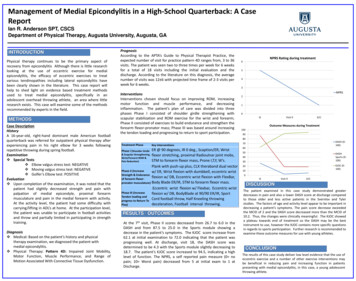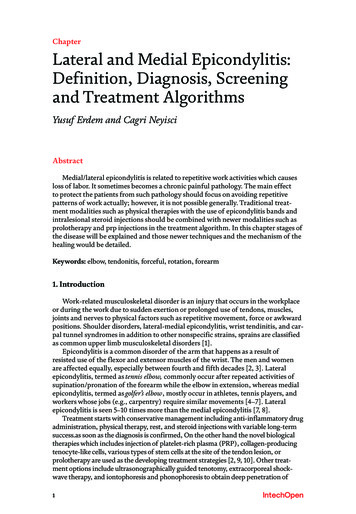Transcription
Treatment options for medial, lateralepicondylitis (tennis, golfer’s elbow)Michael Mathesie and Rob Berman June 28, 20195 minute readWhile there is not an overabundance ofresearch, there are a number of treatmentoptions for lateral epicondylitisEpicondylitis, often referred to as “tennis elbow” or “golfer’s elbow,” is a very commoncondition seen in chiropractic offices. But surprisingly, there are limited literature researchstudies reporting the incidence rate.The current studies show that the incidence rate was approximately 1 to 1.3 percent.1,2 Basedupon an adult U.S. population of 252,063,800 3, this translates to 2,500,000 new cases per year.Lateral epicondylitis diagnoses are somewhat misleading because many who incur theseconditions are neither golfers nor tennis enthusiasts.4 Musicians, construction workers and weight
lifters are frequent sufferers. Even your patients who spend most of their day sedentary in frontof a computer are susceptible. The condition is most prevalent in the age group of 45-54 years.2Why? The muscle-tendon complex is continually stressed through repetitive motions. Theinjuries are considered repetitive stress injuries (RSI).Golfer’s versus tennis elbowBoth injuries involve the epicondyles, however, golfer’s elbow usually involves the medialepicondyle at the tenoperiosteal junction of the flexor carpi radialis tendon.5 Tennis elbowusually involves the lateral epicondyle and the extensor carpi radialis brevis.6Although there is very little scientific data available on the natural history of the disease, 80-90%of patients spontaneously recover within 1-2 years.2 Adhesions tend to form if the patient doesnot refrain from the pain causing activity, thus prolonging the recovery time. Often, referred painis limited. However, pain begins radiating from the elbow to the wrist by overuse and lack ofrest. More fibers become strained as the injury spreads throughout the muscle-tendon unit.Treatment optionsA variety of treatment options are available to the practitioner. Perhaps the most importantconversation is one where the patient is educated to prevent future injuries and exacerbating thecurrent one.Temporary reliefAcute relief is sought by patients while healing is being undertaken. Some of the acutetreatments include: Cryotherapy, whether cold packs or ice massage; typically each application wouldbe for 10 minutes in this region of the body, due to the relatively small thickness ofthe tissue.Analgesics and NSAIDSTopicals that contain ingredients like arnica, camphor, menthol, capsaicin etc.Laser therapyLaser therapy or photobiomodulation (PBM) is a non-invasive effective modality forepicondylitis.5, 6, 7. 8 Although the literature finds contradicting evidence for most modalities,including PBM, there is some high-quality research supporting the benefits of laser therapy fortendinopathies.9, 10, 11, 12, 13 In our experience, beginning treatment at the biceps and triceps and then
moving towards the elbow creates a better result. Why? The photons of energy begin to saturatethe area and start the cascade of biological effects. Those biological effects with lasers are welldocumented and include: Anti-InflammationAnti-Pain (Analgesia)Accelerated Tissue Repair and Cell GrowthImmunoregulationImproved Nerve FunctionImproved Vascular ActivityIncreased Metabolic ActivityReduced Fibrous Tissue Formation (Scars)Trigger Point Resolution and Acupuncture Point StimulationIn addition, one should treat below the elbow to the wrist area because the forearmstructures/fascia are connected to the elbow and are often “stressed” by the repetitive use. Beforeleaving the treatment table patients often report mitigation of discomfort.Treatment applied directly on the skin with firm pressure is preferable to maximize penetration,to limit reflection and scatter, and of course to minimize superficial capillary beds absorbingyour photons before penetration.Long, straight sweeping motions are frequently the best approach. Combining active range ofmotion with the laser therapy will result in a better outcome compared to not using range ofmotion. The elbow joint should be moved through flexion, extension, supination andpronation. This will permit the laser photons to reach more surface area of the underlying tissuesand joints.Friction therapyAlthough the literature does not give much guidance for deep friction massage (IASTM), forchronic cases we find that friction therapy, whether with your hands or tools, helps to reduce theadhesions in the soft tissue that have developed. We recommend laser therapy after the frictiontherapy. Why? The friction therapy tends to produce acute inflammation for which the lasertherapy immediately treats and will accelerate the inflammatory healing process.Adjustments/manipulationWe prefer laser therapy treatment prior to the manipulation, but after transverse friction methods.The muscles, tendons and ligaments tend to have more range of motion after laser therapybecause of the biological effects of PBM. The Mill’s Maneuver-type of manipulation can beperformed immediately after deep transverse friction massage; this technique has shown to bebeneficial for the elbow tendinopathies.14
NutritionIt can be helpful to discuss nutritional needs with the patient, whether you sell supplements ornot. However, the vast amount of nutritional literature does not support any specific nutrient orcombination of nutrients for tendinopathy. 15 However, one article supports vitamin C withcollagen.16 Clinical experience supports a variety of supplements such as omega-3, zinc,magnesium, and vitamins K, B12, folic acid, and vitamin C.StretchingAt-home stretches and exercises help patients maintain the improvements made in your clinic.Teach the patient proper eccentric stretches. Eccentric exercise lengthens the muscle-tendoncomplex resulting in structural remodeling of the tendon with hypertrophy and increased tensilestrength of the tendon. Working with devices like a Flex Bar has been shown to be beneficial. 17Bringing it togetherIt is imperative to become a great clinician and to master the anatomy of the extremities. Thecorrect diagnosis of the tendinosis will allow one to properly treat the condition. The greatclinician must also understand that rest and time are also essential and that not one specificmethod of treatment is superior to others according to the present literature.However, accomplishing relief of acute areas of discomfort will allow patients to perform thestretching and exercises at home that supplement in-office modalities like friction and lasermethods.Michael Mathesie, DC, has practiced in Coral Springs, Fla., for nearly 30 years. He has taughtand utilized laser therapy in his practice since 2005. He is board certified in physicalrehabilitation and forensic science. He can be reached at 954-755-1434 ormathesiechiropractic.com.Rob Berman is a partner at Berman Partners, LLC, a medical-device sales, service, and marketing company. Berman Partners specializes in new and preowned therapeutic lasers. He helpsdoctors improve patient outcomes while increasing physician income. He can be contacted byphone at 860-707-4220 or by e-mail at rob@bermanpartners.com.References1 Bone Joint J 2013;95-B:1158–64.2 Thomas De Smedt, Andy de Jong, et al, Lateral Epicondylitis in tennis: update on aetiology,biomechanics, and treatment, British Journal of Sports Medicine, 2007 Nov; 41(11): 816-819
3 Estimate of the Total Resident Population and Resident Population Age 18 Years and Older forthe United States and Puerto Rico: July 1, 2017 Source: U.S. Census Bureau, PopulationDivision4 Brummel, J Epicondylitis: Lateral Sports Med Arthrosc Rev. 2014 Sep;22(3):e1-6.5 Dimitrios S. Lateral elbow tendinopathy: Evidence of physiotherapy management. World JOrthop. Aug 18, 2016; 7(8): 463-4666 Amin NH, Kumar NS, Schickendantz MS. Medial epicondylitis: evaluation and management JAm Acad Orthop Surg. 2015 Jun;23(6):348-55.7 Lasers Surg Med. 2013 Jul;45(5):311-78 Icyer F, Uzkeser H, Karatay S. Lateral Epicondylitis Treatment: Comparison of Bandage,Laser Therapy and Extra-Corporeal Shock Wave Therapy [abstract]. Arthritis Rheumatol. 2016;68 (suppl 10).9 Bjordal JM, Lopes-Martins RA, Iversen VV. A randomised, placebo controlled trial of lowlevel laser therapy for activated Achilles tendinitis with microdialysis measurement ofperitendinous prostaglandin E2 concentrations. Br J Sports Med. 2006;40:76–80; discussion 7680. [PMC free article] [PubMed]10 England S, Farrell AJ, Coppock JS, Struthers G, Bacon PA. Low power laser therapy ofshoulder tendonitis. Scand J Rheumatol. 1989;18:427–431. [PubMed]11 Lam LK, Cheing GL. Effects of 904-nm low-level laser therapy in the management of lateralepicondylitis: a randomized controlled trial. Photomed Laser Surg. 2007;25:65–71. [PubMed]12 Stergioulas A. Effects of low-level laser and plyometric exercises in the treatment of lateralepicondylitis. Photomed Laser Surg. 2007;25:205–213. [PubMed]13 Stergioulas A, Stergioula M, Aarskog R, Lopes-Martins RA, Bjordal JM. Effects of low-levellaser therapy and eccentric exercises in the treatment of recreational athletes with chronicachilles tendinopathy. Am J Sports Med. 2008. [PubMed]14 Cyriax HJ, Cyriax JP. Cyriax’s illustrated manual of orthopaedic medicine. Oxford:Butterworth-Heinemann, 198315 Federico Fusini, Salvatore Bisicchia, Carlo Bottegoni, Antonio Gigante, Fabio Zanchini,Alberto Busilacchi; Nutraceutical supplement in the management of tendinopathies: a systematic
review; Muscles Ligaments Tendons J. 2016 Jan-Mar; 6(1): 48–57. Published online 2016 May19. doi: 10.11138/mltj/2016.6.1.04816 Shaw, Greg & Lee-Barthel, Ann & Lr Ross, Megan & Wang, Bing & Baar, Keith. (2016).Vitamin C-enriched gelatin supplementation before intermittent activity augments collagensynthesis. American Journal of Clinical Nutrition. 105. 10.3945/ajcn.116.138594.17 Page, Phil. “A new exercise for tennis elbow that works!.” North American journal of sportsphysical therapy : NAJSPT vol. 5,3 (2010): 189-93.
Treatment options for medial, lateral epicondylitis (tennis, golfer's elbow) Michael Mathesie and Rob Berman June 28, 2019 5 minute read While there is not an overabundance of research, there are a number of treatment options for lateral epicondylitis Epicondylitis, often referred to as "tennis elbow" or "golfer's elbow," is a very .







